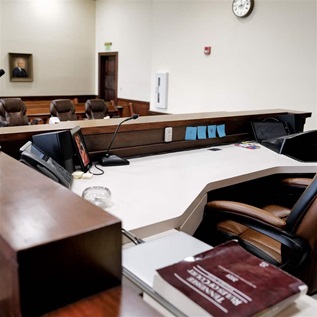Civic Leaders Gather on Independence Mall to Say 'Goodbye Gravel Pit!'
Civic leaders gathered on Independence Mall to celebrate plans to complete the landscaping of Independence Mall, ten years after restoration of the historic park began.
The final enhancements - made possible by the support from the United States government, the commonwealth of Pennsylvania, the city of Philadelphia, The Pew Charitable Trusts and the William Penn Foundation - include the landscaping of the unsightly gravel field opposite the Independence Visitor Center, the demolition of the old Liberty Bell Pavilion and the creation of a First Amendment Rights Area.
"The restored Independence Mall is a testament to what we can accomplish when we all work together," said Rebecca W. Rimel, president and CEO of The Pew Charitable Trusts. "Thanks to numerous public and private organizations that have committed to this ambitious undertaking, we are now able to put the finishing touches on this great American treasure and enable our national icons of freedom to be accessible for all. Today is a great day for Philadelphia and the nation."
"Independence Mall isn't just a Pennsylvania treasure - it's an international treasure," said Governor Edward G. Rendell. "With a world-class Independence Mall completed, we invite all residents and visitors to fully experience the cradle of democracy."
The new planting, paths and lawns, as well as decorative pavers, benches and lighting fulfills the Olin Partnership's vision of a green campus-like setting for the major institutions that line Independence Mall. The old Liberty Bell Pavilion, where the bell hung from the time of the Bicentennial in 1976 until its move to the Liberty Bell Center in October 2003, will be demolished by Spring 2006. Today's announcement complements plans to commemorate and interpret the President's House, where presidents Washington and Adams once lived and where Washington brought enslaved Africans from his Mt. Vernon plantation.
The rebuilding of Independence Mall, which has cost close to $300 million to date, is a true Philadelphia success story involving many public and private partners. Nine city blocks were demolished in the 1950s to create the Mall, which, over time, had become underused and in disrepair - a civic embarrassment. In the past decade, however, the Mall has undergone a remarkable renaissance. During that period, three important civic buildings have been built - the National Constitution Center, the Independence Visitor Center and the new Liberty Bell Center - greatly improving the region's ability to educate and serve visitors. With the landscaping complete, Independence Mall will finally have the beauty and vitality envisioned half a century ago.
"This final landscaping will unite all of these great buildings on the mall, which will continue to be the focal point for millions of visitors to the Philadelphia region," said Dennis Reidenbach, interim superintendent of Independence National Historical Park. "And we're not stopping there. We plan to raise an additional $3.5 million to construct an outdoor cafe and further enhance the landscaping by July 2007."
The Pew Charitable Trusts, which has invested close to $20 million since 1996 to transform Independence Mall, provided $2.5 million to support this final push to complete the landscaping. Earlier today, the William Penn Foundation's board of directors approved a $1 million grant to support the landscaping project. The state is contributing $6 million and the federal government $1.9 million. The federal and city governments have committed $5.1 million for the President's House commemoration, an integral part of the Independence Mall's completion. Plans call for the final round of landscaping, including the demolition of the Liberty Bell Pavilion and greening of the "gravel pit," to be completed by July 4, 2006.











